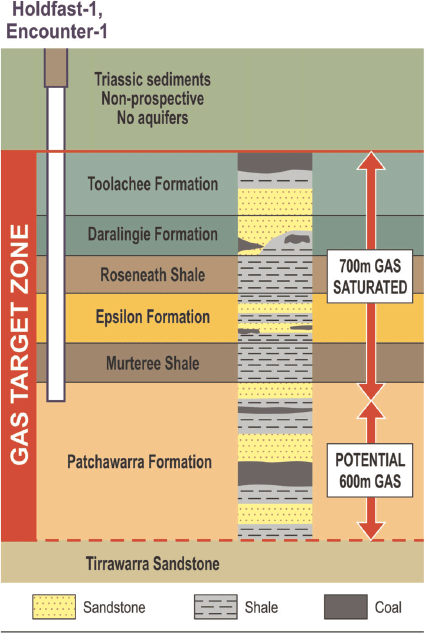The Nappamerri Trough, Cooper Basin unconventional plays: proving a hypothesis
C. Trembath A , L. Elliott A and M. Pitkin ABeach Energy.
The APPEA Journal 52(2) 662-662 https://doi.org/10.1071/AJ11076
Published: 2012
Abstract
Beach Energy has started exploring unconventional gas in the Nappamerri Trough, the central trough within the Cooper Basin, where the Permian section has long been regarded as the primary source for most of the conventional hydrocarbons found within the basin.
This extended abstract discusses the data used to identify the unconventional play and the exploration program carried out to date. Mud weights, drill stem test (DST) pressures and log data from early exploration wells identified the Permian formations as overpressured. This with geochemical and mineralogy analyses indicated that the Roseneath and Murteree Shales had potential similar to successful shale gas plays being developed in the USA.
The quartz and siderite content within both shale sections indicated sufficient brittleness for successful fracture stimulation. In addition, the Nappamerri Trough Permian section showed low permeabilities, which, when combined with overpressure, suggested a basin-centred style play within the Epsilon and Patchawarra sandstones and possibly the Toolachee Formation sandstones.
During 2010–11, Beach drilled two exploration wells sited outside structural closure to test both the shale gas and basin-centred gas system. Both wells have now been fracture stimulated, with very encouraging gas flows from the Roseneath to Patchawarra section. The latest geological data confirms the pre-drill potential for both gas flow from the shales and the presence and production of gas from sandstones outside structural closure, resulting in a significant shale and tight gas resource booking. Ongoing exploration and development will target a potential 300 Tcf gas in place in PEL 218.
Introduction
In 2007, recognising the potential significance of shale plays in the USA, Beach Energy embarked on a review of these plays to determine whether similar geological analogues could be developed in Australia. The review highlighted that many parameters can be measured and considered; however, organic content, maturity, thickness, and proximity to infrastructure were identified as key contributors to success. Historical exploration data from several Australian basins were reviewed and, where required, augmented with further analysis of stored cutting material.
The Nappamerri Trough was short-listed based on favourable location and geochemistry. Beach further high-graded the trough as the data suggested the potential for a basin-centred play in the associated sands in the Permian section. As a result, in 2008 and 2009, Beach farmed into two significant permits in the trough.
Beach started a two-well vertical exploration project in 2010. In addition to an extensive coring and analysis program, the wells were designed for fracture stimulation and flow testing. In 2011, Beach successfully stimulated and flow tested Holdfast-1 from both the shale gas and basin-centred gas plays. A comprehensive geological and engineering data set has been built to design the follow up horizontal shale deliverability wells and vertical basin-centred exploration wells that will commence drilling in 2012.
Nappamerri Trough, Cooper Basin
The Nappamerri Trough is the deepest and largest of three northeast–southwest trending depocentres within the Late Carboniferous to Middle Triassic aged Cooper Basin (Fig. 1). Extensive drilling in the southwest portion and on the flanks of the trough proved up many commercial Permian gas fields. The Nappamerri Trough contains a thick Permian section of sandstones, coals, siltstones, and shales deposited in a cold climate fluvio-lacustrine setting. Changes in depositional environments between fluvial, lacustrine, and deltaic have resulted in stacked multiple targets within a proven hydrocarbon province.
The Roseneath Shale, Epsilon Formation, and Murteree Shale (REM) were initially the main focus of shale gas assessment in the Nappamerri Trough. Historically, the thick shale units of the Roseneath and Murteree were considered to be regional seals. The main source units for the Cooper Basin were thought to be the coals and organically rich shales within the Patchawarra and Toolachee Formations; however, more recent geochemical investigations reveal that both the Roseneath and Murteree Shales have also been a significant source of hydrocarbons within the Nappamerri Trough.
Worldwide, there were no pre-existing analogues for the Nappamerri Trough shale play because all of the commercially produced shale gas plays in North America involve marine rather than lacustrine shales.
Historical data
Prior to 2010, nine petroleum exploration wells had been drilled in the Nappamerri Trough between 1971 and 2001, targeting the Permian gas reservoirs within conventional structural closures. Data from these wells were used to make an assessment of the shale gas potential. Due to low tectonic activity in the Nappamerri Trough, the Permian formations are laterally continuous within minimal variation in thickness of the shale units.
Thinning of the Permian strata occurs only towards the flanks of the trough where they are truncated by Permian and Triassic thrusts. Individual shale unit thickness of about 70 m indicates they are of sufficient thickness compared to successful US shale plays. Vitrinite reflectance data indicates that variable maturity gradients exist in the Permian section. The prospective REM section has a vitrinite reflectance of 2–4% with the exact level of thermal maturity depending on location within the Trough (Fig. 2a). With the high level of maturity, the Permian sequence is expected to be within the dry gas window. Gas recoveries from DSTs support that expectation.
DSTs and mud weights indicate that the Epsilon and Patchawarra Formations are over-pressured and that the over-pressure is confined to the Nappamerri Trough. The regional pressure gradient is 0.43 psi/ft, while the pressure gradient in Nappamerri Trough, based on DST information across the Epsilon and Patchawarra Formation, is about 0.72 psi/ft (Fig. 2b).
Previous RockEval analysis had suggested that inertinite dominated the REM section and that the shales were poor source rocks. Cuttings were re-analysed, following removal of the carbonate cements, and showed that good quality Type II kerogens dominate (Fig. 2c) and that TOCs within the Roseneath and Murteree Shale generally range from 2 to 4%, and up to 7% TOC within the Epsilon Formation. The high TOC and HI values, particularly given the maturity, are encouraging.
The mineralogy of the shales is consistent with the successful Barnett and Haynesville shale plays (Fig. 2d), with high silica content being beneficial in hydraulic fracture placement and productivity. The presence of about 10% siderite in the shales of the REM also increases the brittleness. As is expected from the section maturity, illite is the dominant clay type, with sub-dominant kaolinite.
The existing exploration wells intersected gas saturated, low permeability sandstones within the Epsilon and Patchawarra Formations. Although many DSTs were conducted in these wells, there was no evidence of formation water being produced and gas-water contacts were not identified from either pressure or log data; therefore, the potential was recognised for the Nappamerri Trough to represent a large basin-centred gas play that encompassed the low permeability, over-pressured sandstones as well as the REM play.
Based on the shale gas and basin-centred gas play potential within the Nappamerri Trough, Beach Energy farmed into PEL 218, a 1,600 km2 exploration permit in the South Australian portion of the Central Nappamerri Trough and the similarly sized ATP855P exploration permit within the Queensland portion (Fig. 1). Two vertical exploration wells were proposed in PEL 218 with the primary aim of assessing the shale gas potential of the REM interval, as well as determining if a basin-centred gas play existed in the low permeability sands within the Toolachee, Epsilon, and Patchawarra Formations.
Encounter-1 and Holdfast-1
Encounter-1 and Holdfast-1 were drilled in late 2010/early 2011 within PEL218 to assess the REM using extensive coring and logging and later fracture stimulation. The wells were intentionally drilled outside of structural closure to test the hypothesis of the basin-centred gas play.
Encounter-1 was drilled 50 m into the Patchawarra Formation and intersected a thicker-than-expected Permian section. Log analysis and mudlog gas shows reads during drilling indicate all Permian formations are gas saturated, including the top 50 m of Patchawarra Formation, confirming the basin-centred gas potential in a section potentially greater than 1,000 m (Fig. 3). Cores were acquired in the REM and extensive core analyses carried out. Desorption analysis of the shales indicated better-than-expected gas content. TOC, maturity, and mineralogy were all consistent with pre-drill expectations. Encounter-1 was cased and suspended for future fracture stimulation.

|
Holdfast-1, located about 20 km northwest of Encounter-1 (Fig. 1), intersected a Permian sequence close to prognosis. More than 350 m of full hole core through the target REM and Patchawarra Formation was recovered. Core analyses results were consistent with pre-drill expectations and demonstrated the relative lack of lateral variability in shale mineralogy and organic content between wells. Log analysis indicated that the Permian sand section in Holdfast-1 was also gas saturated, including the drilled portion of the Patchawarra Formation.
In June 2011, Holdfast-1 was fracture stimulated. A total of seven zones were stimulated, one in the Patchawarra Formation, one in the Murteree Shale, three in the Epsilon Formation, and two in the Roseneath Shale. During the fracture stimulations, various proppant size, pump rates, and gel systems were trialled to gather information for future well stimulations. Tiltmeter survey tools were also used to confirm vertical fracture orientation. A very encouraging initial flow rate of up to 2 MMcfd was achieved and a production logging run after two weeks of production indicated that all formations stimulated were contributing to the gas flow rate.
The successful fracture stimulation and gas flow rate from Holdfast-1 was a significant milestone. It not only confirmed the pre-stimulation assessment of the REM and Patchawarra Formations as being gas saturated, but it also demonstrated that the gas within both the low permeability sandstones and the shales could be produced to surface.
Conclusion
As a result of an extensive review of existing well data within the Nappamerri Trough, Beach Energy drilled two dedicated shale gas wells with acquired core and log data supporting the initial assessment of the Nappamerri Trough being a potential shale gas play. By drilling into the top of the Patchawarra Formation, the potential for the trough to be part of a larger basin-centred gas play was also confirmed. The vertical and lateral extent of the basin-centred gas play will be further appraised in the 2012 drilling campaign.
References
Alexander, E., 1998—Lithostratigraphy and environments of deposition. In Gravestock, D.I., Hibburt, J.E., and Drexel, J.F. (Eds), The petroleum geology of South Australia, Volume 4: Cooper Basin. Report Book 98/9. Adelaide: Primary Industries and Resources (PIRSA) SA, 69–115.Hillis, R. R., Morton, J. G. G., Warner, D. S., and Penney, R. K. (2001). Deep basin gas: a new exploration paradigm in the Nappamerri Trough, Cooper Basin, South Australia. APPEA Journal 41, 185–200.

Carrie Trembath graduated from the University of Melbourne in 2001 (BSc, hons) and joined Santos as a graduate geologist. After five years working as a development geologist and petrophysicist, she joined Schlumberger as a borehole geologist in Oman. She returned to Australia to work as a petrophysicist at Nexus Energy and Mosaic Oil, before joining Beach Energy in 2010 where she is now working in the unconventional resources team as a geologist and petrophysicist. Member: PESA, FESAus, and SPWLA. |

Lindsay Elliott is a geologist with nearly 40 years in the petroleum exploration industry. He has worked for Esso, CSR, AGL, Santos, and is now at Beach after a short period of consulting. During his career, he has worked on most Australian basins and many overseas. He is now undertaking new venture evaluations for Beach. Member: PESA and AAPG. |

After graduating with a degree in petroleum engineering (UNSW) in 1991, Mark joined Santos as a reservoir engineer. After seven years working on field development of retrograde and tight gas fields, he headed to Japan. He returned to Santos in 2000 prior to joining Origin Energy CSG in 2001 where he was the reservoir development engineer behind the successful Spring Gully CSG field. In 2007, Mark joined Beach Energy, where he is now the co-ordinator of unconventional resources, leading the team that has been exploring and appraising the shale gas play in the Nappamerri Trough. |




